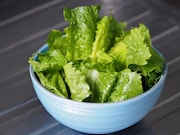Romaine lettuce sold in stores to carry labels with region where produce was grown, harvest date
TUESDAY, Nov. 27, 2018 (HealthDay News) — In a statement released late yesterday, the U.S. Food and Drug Administration Commissioner Scott Gottlieb, M.D., announced that the agency was lifting its advisory against eating romaine lettuce, first put in place last Tuesday. At that point, the agency had not been able to narrow down the source of the tainted lettuce. But now the source seems to be “end-of-season” lettuce harvested somewhere in the Central Coast regions of central and northern California. And “harvesting of romaine lettuce from this region has [already] ended for the year,” Gottlieb noted.
Starting as early as this week, romaine lettuce sold in stores will carry labels listing the region where the produce was grown along with its harvest date, the FDA said. By checking these labels, consumers can quickly determine that the produce is safe to eat. “Romaine lettuce that was harvested outside of the Central Coast growing regions of northern and central California does not appear to be related to the current outbreak,” Gottlieb stressed. Romaine lettuce farmed in Arizona, Florida, and Mexico, as well as California’s Imperial Valley is safe to consume. “Hydroponically- and greenhouse-grown romaine also does not appear to be related to the current outbreak,” Gottlieb added. “There is no recommendation for consumers or retailers to avoid using romaine harvested from these sources.”
If heads of romaine are sold loose without affixed labels, retailers are being asked to post a notice showing place and date of harvest near the store register. Such labeling may become standard going forward, according to an agreement between the FDA and the leafy greens industry, the agency said.
So far, 43 people across 12 states have been sickened in this latest outbreak of Escherichia coli, with onset in the last case occurring on Oct. 31. Twenty-two more cases have been reported in Canada. No deaths have yet been reported in the outbreak. “Through laboratory studies we have identified that the E. coli O157:H7 strain causing the outbreak is similar to one that produced an outbreak of E. coli O157:H7 in the fall of 2017 that also occurred in the United States and Canada, which was associated with consumption of leafy greens in the United States and specifically romaine lettuce in Canada,” Gottlieb said.
More Information: FDA
More Information: CDC
Copyright © 2018 HealthDay. All rights reserved.








